The Pulpit
The Middle Bass Chapel Association identified and recruited ministers each year to preach in the Chapel for 8 Sundays in July and August. To locate the ministers, the Middle Bass Chapel Association Trustees or an appointed committee would solicit ministers from their hometowns or designated cities and invite the ministers to come to Middle Bass Island to preach during the summer. The Middle Bass Chapel Association could easily entice leading men to fill the pulpit because the Middle Bass Club was a beautiful place to visit, and the membership included prominent, wealthy and powerful families.
From the Annual Meeting on August 6, 1883: “ A motion was made that the committee of last year, Mrs. Edward C. Bodman and Mrs. William H. Currier, be reappointed for this year with authority to invite a clergyman to officiate each Sunday of July and August, paying $10 a Sunday. Carried.” The Secretary would then send a written invitation to the ministers to confirm the date they would be available to preach at the Chapel. The ministers were paid for their services: $10 and two days lodging in the Middle Bass Club House. The pulpit compensation was increased to $15 in 1897, $20 in 1902, $25 in 1905 and $30 in 1906. In 1900, from a financial standpoint, the Middle Bass Chapel Association decided to enlist ministerial services for only 6 Sundays in the summer, omitting the first 2 Sundays in July.
The Pulpit – Ministers
According to the Records Book, ministers came from the following Ohio cities: Akron, Cincinnati, Cleveland, Columbus, Gambier (Kenyon College), Granville (Denison University), Findlay, Lima, Massillon, Newark, Put-in-Bay (Gibraltar Island), Sandusky, Talmadge and Toledo. Additionally, ministers traveled from out of state to preach in the Middle Bass Club Chapel: Adrian, Michigan; Detroit, Michigan; LaGrange, Illinois; Philadelphia, Pennsylvania; Pittsburgh, Pennsylvania and St. Louis, Missouri. A link to a complete list of the clergy that held services in the Middle Bass Club Chapel is listed below.
![]() Middle Bass Club’s Chapel Ministers
Middle Bass Club’s Chapel Ministers
Since the majority of the Middle Bass Club members resided in Toledo, ministers from prominent Toledo churches were often invited to preach at the Chapel. Many clergy from the First Congregational Church of Toledo came to Middle Bass Island because their congregation included the wealthy, prestigious families of Toledo’s Old West End. In fact, the following Middle Bass Club members belonged to the First Congressional Church: John Berdan II and his sons Lucius B. Berdan and Sinclair Berdan, Peter Frederick Berdan and his son Frederick T. Berdan, Leander Burdick, Symmes Henry Bergen, Leander Burdick, Walter J. Chase, Abram Walter Colton, Judge John Hardy Doyle, Frederick K. Eaton, Isaac Newton Poe, Charles Harvey Scribner, James K. Secor and Adelbert Lorenzo Spitzer.
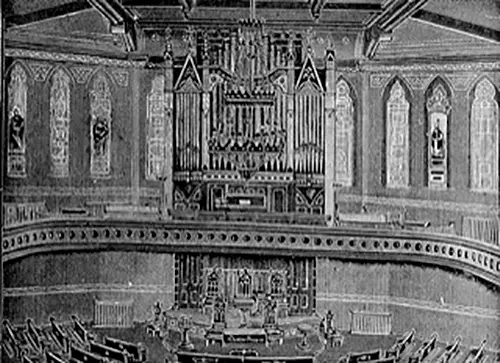 The Old First Church Interior looking down toward the pulpit and organ loft. Source: The Evolution of a School Master autobiography part 2, 1872-1899, p. 88
The Old First Church Interior looking down toward the pulpit and organ loft. Source: The Evolution of a School Master autobiography part 2, 1872-1899, p. 88
Rev. William Wallace Williams
Rev. William Wallace Williams of Toledo’s First Congregational Church held services eight Sundays in the Middle Bass Club Chapel, specifically: July 27, 1884; July 19, 1885; July 25, 1886; August 7, 1887; July 29, 1888; August 25, 1890; August 28, 1892 and August 2, 1896. Rev. Williams graduated from Amherst College in 1843 and Auburn Theological Seminary in 1846. After being ordained and working in Camillus, New York, Rev. Williams was installed in the First Congregational Church in Toledo on September 1, 1853. He served 44 consecutive years as a pastor in Toledo (1853 - 1897) thus ensuring he had personal and professional relationships with Middle Bass Club members. In March 1987, Rev. Dr. Williams offered his resignation and the First Congressional Church granted him the title of pastor emeritus.” (Source: Find A Grave)
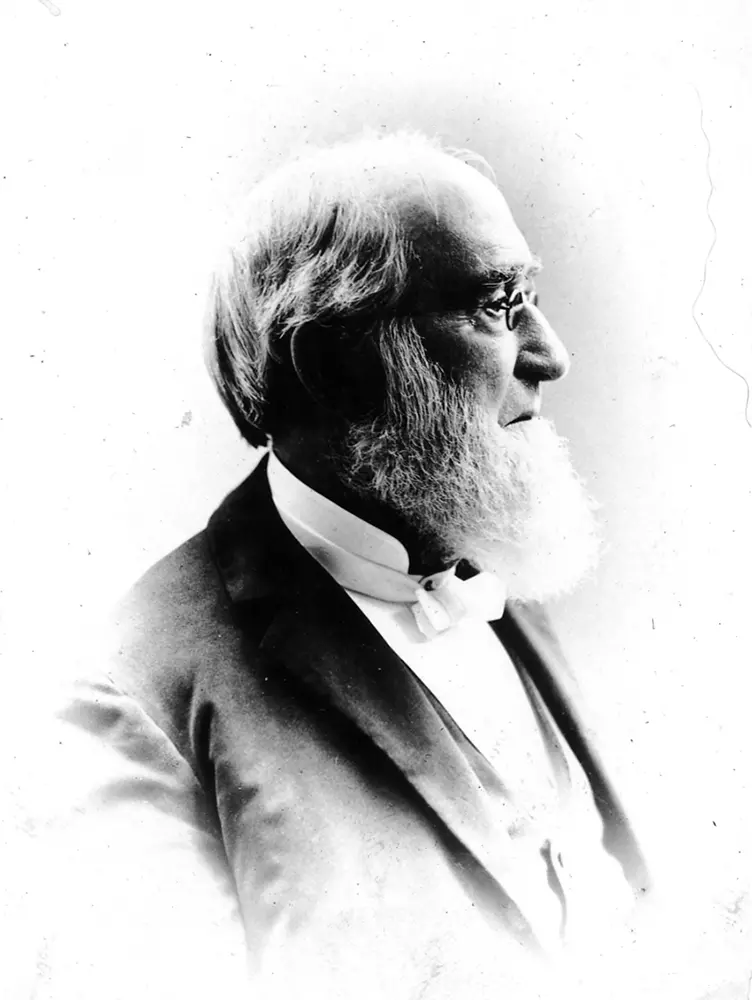 Rev. William Wallace Williams, Pastor First Congregational Church of Toledo, Ohio Source: The Evolution of a School Master autobiography part 2, 1872-1899, p. 85
Rev. William Wallace Williams, Pastor First Congregational Church of Toledo, Ohio Source: The Evolution of a School Master autobiography part 2, 1872-1899, p. 85
From Rev. Fisk’s Autobiography, “This church [First Congregational Church of Toledo] had been already forty-one years under the pastorate of its now seventy-one year old minister, Dr. W. W. Williams. It was the oldest, and in some ways the most notable church of Toledo, and in a very true sense. Dr. Williams was the church, for he had bred it up both materially and otherwise to be what it was. For some years there had been attempts to give the aging pastor an associate, or assistant pastor, but hitherto he had managed to side-track all efforts to secure the service of a younger man.” (Source: The Evolution of a School Master autobiography part 2, 1872-1899, p. 85.) He went on to describe the First Congregational Church as “the Mother Church” of Toledo, one of its strong churches, with membership of over 600.” (Source: The Evolution of a School Master autobiography part 2, 1872-1899, p. 87.)
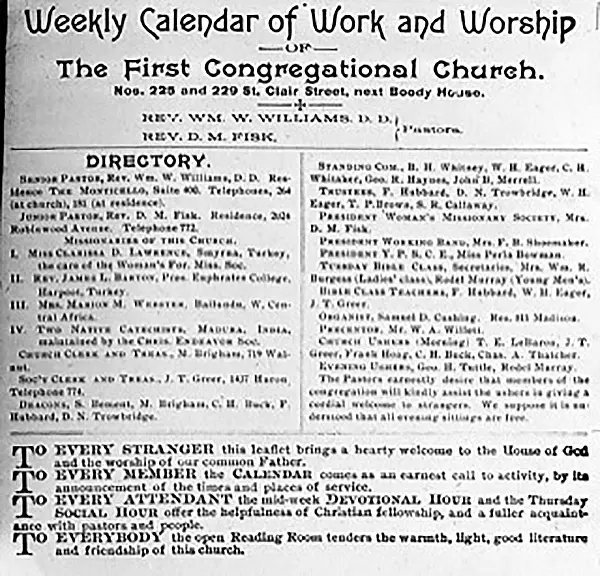 Weekly Calendar of Work and Worship Source: The Evolution of a School Master autobiography part 2, 1872-1899, p. 90
Weekly Calendar of Work and Worship Source: The Evolution of a School Master autobiography part 2, 1872-1899, p. 90
Rev. Daniel Moses Fisk
Rev. Daniel Moses Fisk from the First Congregational Church in Toledo, Ohio came to preach in the Middle Bass Club Chapel on: July 3, 1892; July 2, 1893 and July 5, 1896. Rev. Fisk received his education from Brown University and Harvard Medical School. He taught biology at Hillsdale College from 1872 until 1886 and became an ordained minister in Jackson, Michigan in 1886. In 1891, Rev. Fisk came to the First Congregational Church in Toledo, Ohio as a junior pastor and remained there until 1896. According to Rev. Fisk, “[First Congregational Church] not only held large wealth, but its pew-holders were essentially the leaders of the most exclusive social set of the town. Indeed, to hold a pew in the “Old First” was pretty nearly a vised passport to standing in Toledo’s first circles. For years, this church had sought, and had very largely secured the pace-makers in finance and fashion. The dignified pulpit in that great auditorium looked to the invited candidate [Rev. Fisk] a “throne of power.” This farmer-bred son [Rev. Fisk] had as yet no experience with millionaire parishioners; with folk who gave $5 a year to foreign missions, and spent $10,000 on a show wedding or the races.” (Source: The Evolution of a School Master autobiography part 2, 1872-1899, p. 88)
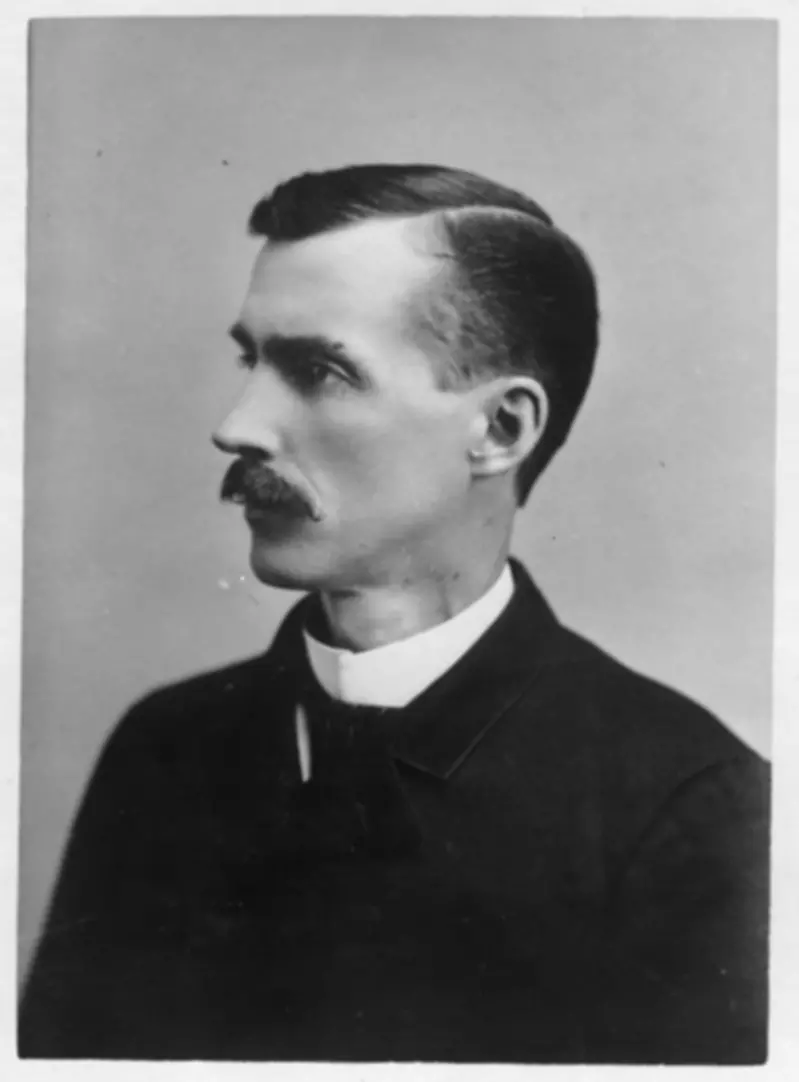 Rev. Daniel Moses Fisk, Toledo, Ohio, Age 45. Source: The Evolution of a School Master autobiography part 2, 1872-1899, p. 91
Rev. Daniel Moses Fisk, Toledo, Ohio, Age 45. Source: The Evolution of a School Master autobiography part 2, 1872-1899, p. 91
After Toledo, Rev. Fisk’s Congregational pastorates included: Compton Hill Church, St. Louis, Missouri 1897-1899 and First Church, Topeka, Kansas 1899–1902. Rev. Fisk received a Ph. D. from Findlay College in 1890 and a Doctor of Divinity from Hillsdale in 1897. From 1899 until he retired in 1924, Rev. Fisk was a Sociology Professor, field worker (recruiter) and Trustee at Washburn College in Kansas. Upon retirement, Rev. Fisk was named professor emeritus and given an annual salary of $2,500. (Source: The Ichabod (Washburn College), October 1932, p.1)
Rev. Albert Marion Hyde
Rev. Albert Marion Hyde from the First Congregational Church of Toledo led services in the Middle Bass Club Chapel on August 27, 1899; August 24, 1903 and July 8, 1904. After Rev. William’s resignation in March 1897, Rev. Hyde came from his initial pastorate at Greenville, Michigan to lead the “Old First” at Toledo. Due to his preaching power and constant work, Rev. Hyde increased the church’s membership from 450 to 922 illustrating that he was well acquainted with the Middle Bass Club members in his parish. (Source: Find A Grave) In fact, the Guest Register book shows that Rev. Hyde checked into the Middle Bass Club on Saturday August 26, 1899 and stayed at a cottage rather than at a room in the Club House. Unfortunately, the Guest Register does not specify in which cottage he was a guest.
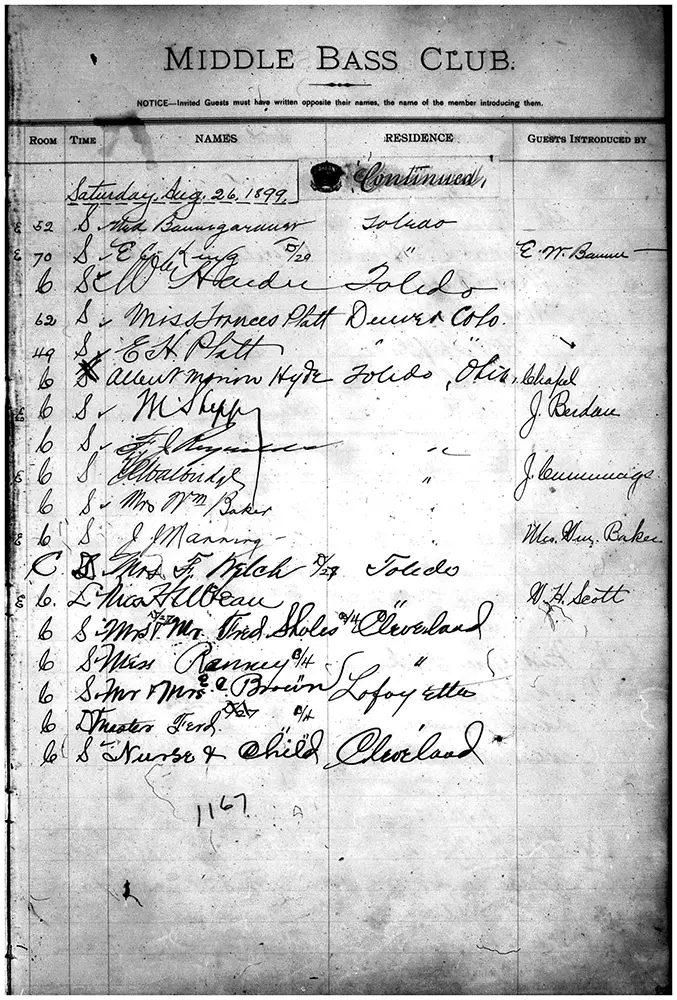 1899 Middle Bass Club Guest Register book
1899 Middle Bass Club Guest Register book
Later, Rev. Hyde went to the Porter Congregational Church in Massachusetts where he caused a sensation by circulating among the women of his parish ten commandments for wives, Commandments for Convenience which included, “Thou shalt not marry for a bank account nor even to escape being an old maid. It is better to remain single all thy life than to enter into the matrimonial state for revenue only.” (Charlotte Evening Chronicle, December 15, 1911) Later Rev. Hyde formulated commandments for young men which included, “Do not invest your nickel in a glass of beer, then criticize the other fellow who has invested his in a savings bank. Beer checks and savings bank checks as investments are not in the same class.” (Source: New Your Times, December 13, 1911). Rev. Hyde’s also created ten commandments for husbands which said, “Don’t arrange for your second marriage before your first wife is dead.” (Source: New Your Herald, January 1, 1912).
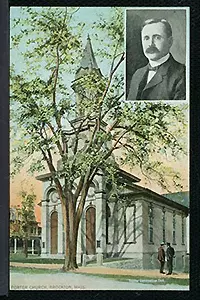 A postcard of the Porter Congregational Church where revered Hyde was a Pastor. Link to the Digital Library
A postcard of the Porter Congregational Church where revered Hyde was a Pastor. Link to the Digital Library
Another Toledo church popular with the Middle Bass Club families was Trinity Episcopal Church, a massive gothic stone building located downtown. Many reverends from Trinity Episcopal Church came to the Chapel because their parish included the following important Middle Bass Club members: Leander Solomon Baumgardner, Oliver S. Bond, Calvin Bronson, Charles F. Curtis, James B. Monroe, Sheldon Clark Reynolds and his son Frederick Jesse Reynolds, Frederick Jesse Reynolds, William H. Simmons, Denison Billings Smith, Jr., George E. Welles, Horatio Sam Young and Morrison Waite Young.
Rev. Edward Robert Atwill
Rev. Edward Robert Atwill of the Trinity Episcopal Church led services in the Middle Bass Club Chapel on July 13, 1884 and July 31, 1887. Later Rev. Atwill became Bishop of the Episcopal Diocese of West Missouri.
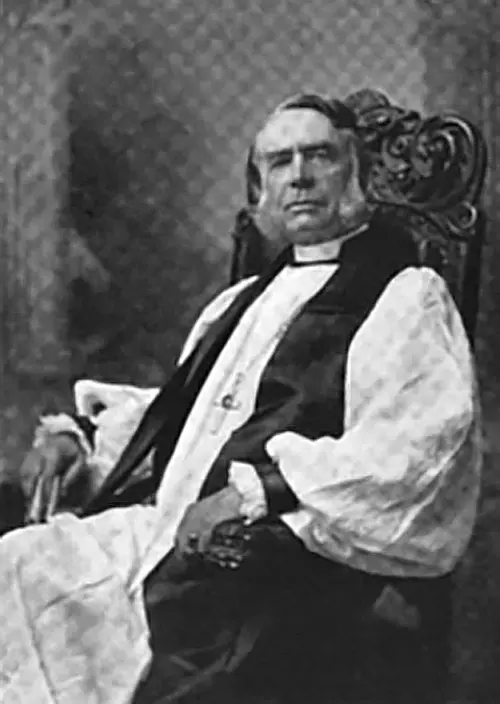 Rev. Edward Robert Atwill. Source: Find A Grave
Rev. Edward Robert Atwill. Source: Find A Grave
Rev. Charles Scadding
Rev. Charles Scadding led twelve services in the Middle Bass Club Chapel: July 10, 1892; July 23, 1893; July 16, 1894; August 30, 1896; August 4, 1901; August 11, 1901; August 10, 1902; August 3, 1903; August 7, 1904; August 14, 1904; July 22, 1906 and July 29, 1906. “Reverend. Charles Scadding graduated from Trinity College in 1885 and entered the priesthood in 1886. He served as rector in Christ Church in Middletown, New York, Trinity Church in Toledo, Ohio and assistant rector at St. George’s Episcopal Church in Manhattan and served as the 3rd Bishop of the Episcopal Diocese of Oregon from 1906 – 1914. He was also a lecturer of the London Society for the Propagation of the Gospel.” (source: Wikipedia) Rev. Scadding would have been in contact with many Middle Bass Club members because he followed in the footsteps of Rev. Edward Robert Atwill who also led services in the Middle Bass Club. Rev. Scadding’s second marriage to Mary Robinson Pomeroy in 1899 provided another connection to the Middle Bass Club as Mary Robinson Pomeroy’s brother, George Eltweed Pomeroy Jr., was a member of the Middle Bass Club from 1888 to 1907. Based on 1901 Guest Book records, Rev. and Mrs. Scadding arrived at the Middle Bass Club on Thursday, July 30th and stayed in room 68 at the Club House while Rev.’s Scadding’s brother in law, George E. Pomeroy, stayed in room 60 at the Club House. This is another example highlighting the personal relationships between the clergy and the Middle Bass Club membership.
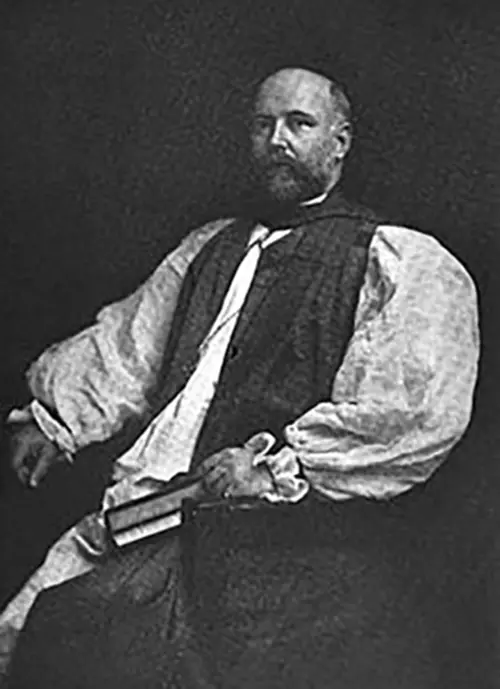 Rev. Charles Scadding Source: Wikipedia
Rev. Charles Scadding Source: Wikipedia
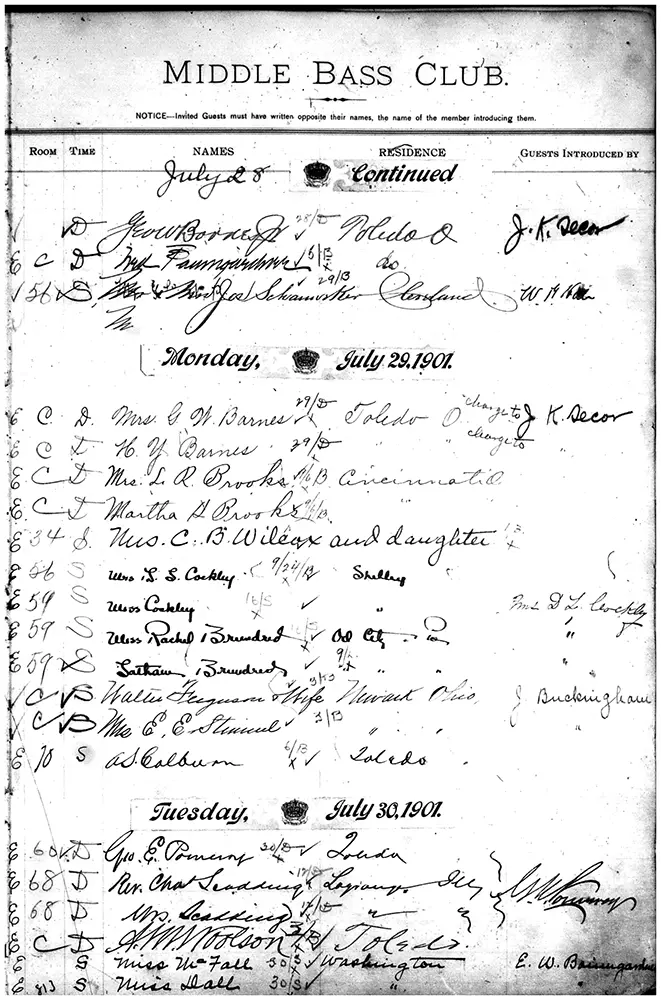 Middle Bass Club Guest Register Book Entry: July 30,1901
Middle Bass Club Guest Register Book Entry: July 30,1901
Based upon my research, all the ministers were prominent men in their field and most had a personal relationship with at least one Middle Bass Club member. Other significant reverends who led services in the Middle Bass Club Chapel are listed in alphabetical order below.
Rev. Cyrus S. Bates
Rev. Cyrus S. Bates of the St. Paul’s Episcopal Church in Cleveland, Ohio led services in the Middle Bass Club Chapel on August 22, 1886 and August 21, 1887. Rev. Bates fought for the Union in the Civil War and was wounded at the Battle of Chickamauga. After the war, he practiced law in Cincinnati and then entered Bexley Theological Seminary, part of Kenyon College, where he graduated in 1873. After servicing churches in Lima and Newark he returned to Kenyon College. In 1878, Rev. Bates was a Professor of Mental and Moral Philosophy and a Professor of Dogmatic Theology in Bexley. In 1885, he became rector of St. Paul’s Episcopal Church in Cleveland, Ohio while remaining a Trustee with Kenyon College. (Source: Kenyon College Library)
Rev. Dr. William Budd Bodine
Rev. Dr. William Budd Bodine, President of Kenyon College, held services in the Chapel on July 24, 1887 and July 15, 1888. Kenyon College was the first Episcopal College and Seminary outside the original 13 Colonies and was well known in the 1860s as evidenced by the education of numerous Chapel ministers. (Source: St. Paul’s Episcopal Church, Put in Bay, Ohio) Rev. Bodine was a New Jersey native who graduated from Princeton in 1860 before attending Bexley Hall, the seminary at Kenyon College, until 1864. Rev. Bodine served as chaplain and President of Kenyon College from 1876 to 1891. He died in 1907 while serving as church rector in Pennsylvania. (Source: Kenyon College Library)
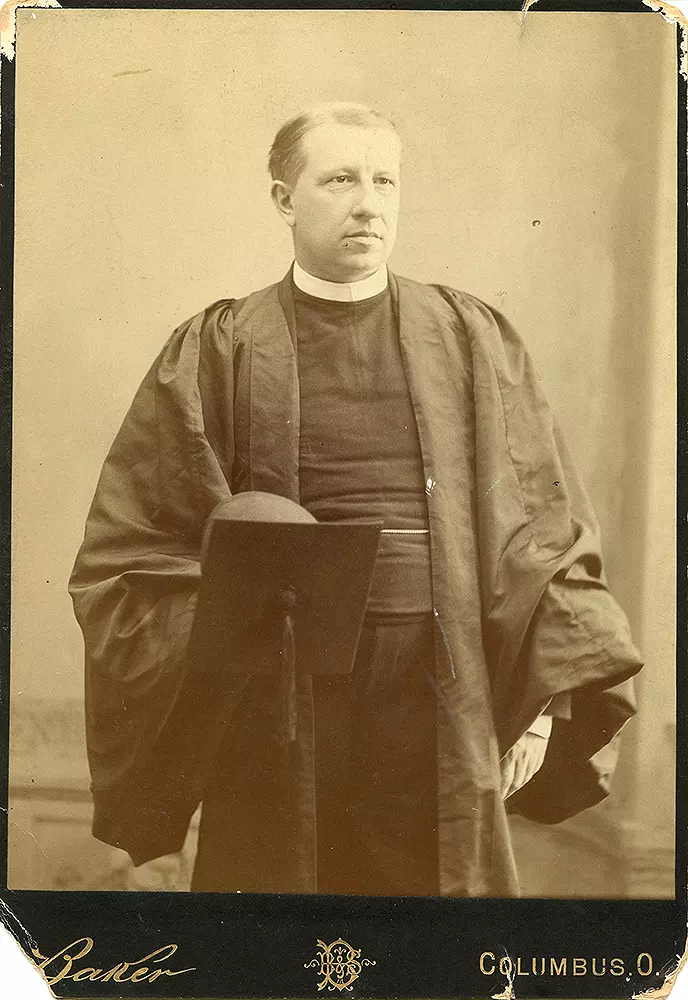 Rev. Dr. William Budd Bodine, Source: Kenyon College Library, Gambier, Ohio
Rev. Dr. William Budd Bodine, Source: Kenyon College Library, Gambier, Ohio
Rev. Henry E. Cooke
Rev. Henry E. Cooke, Episcopalian, from Manchester, New Hampshire and Gibraltar Island conducted two services at the Chapel on August 16, 1891 and August 23, 1891. Rev. Cooke spent time on Gibraltar Island because his father Jay Cooke, known as the “(Union) financier of the Civil War, bought the island. Gibraltar Island is located in the harbor of Put in Bay just across from Middle Bass Island in Lake Erie. From Cooke’s Castle on Gibraltar, Rev. Cooke would have been able to see the Middle Bass Club House. Because Jay Cooke endowed a chair at Kenyon College, he was in contact with leading Episcopal ministers many of whom led services in the Middle Bass Club Chapel. Besides locational proximity, Rev. Cooke had a personal relationship with the Middle Bass Club membership because his son Russell Cooke (Sr.) married Middle Bass Club member Alice Reeve Kelsey in 1912. She is the granddaughter of Middle Bass Club member Aaron Lufkin Kelsey and his wife Helen Mar Lawton and the daughter of Middle Bass Club member Hiram Reeve Kelsey and his wife Alice Gladstone Young.
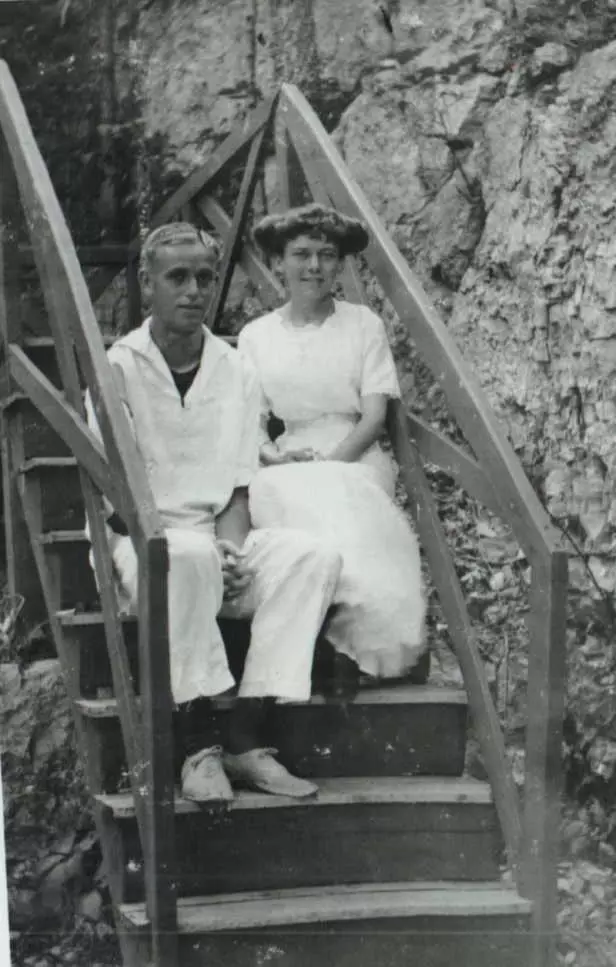 Russell Cooke (Sr.) & Alice Reeve Kelsey. The couple was married in 1912. Perhaps this photo was taken at the Middle Bass Club or Gibraltar Island in Lake Erie? Source: Ancestry
Russell Cooke (Sr.) & Alice Reeve Kelsey. The couple was married in 1912. Perhaps this photo was taken at the Middle Bass Club or Gibraltar Island in Lake Erie? Source: Ancestry
Rev. Frederic Beal DuVal
Rev. Frederic Beal DuVal from the Westminster Presbyterian Church of Toledo led services in the Chapel on July 26, 1885 and July 18, 1886. Rev. DuVal graduated from Princeton University and Princeton Theological Seminary. Before coming to Toledo in 1884, he served a pastor in the First Presbyterian Church in Wilmington, Delaware. After Toledo, Rev. DuVal served as minister of Knox Presbyterian (United) Church in Winnipeg, Canada. While in Canada, he was elected Moderator of the General Assembly of the Presbyterian Church of Canada in 1908, represented the Canadian Presbyterian Church at the Tercentenary celebration in Quebec in 1908 and represented the Canadian Presbyterian Church at the World’s Presbyterian Council at New York in 1909. (Source: Manitoba Historical Society website, Memorable Manitobans: Frederic Beal DuVal (1847-1928)
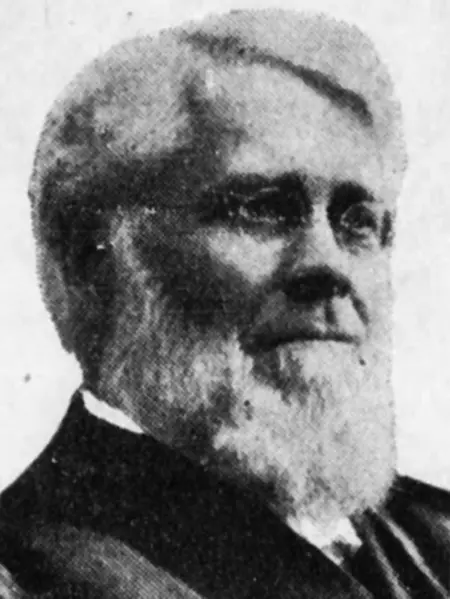 Rev. Frederic Beal Duval. Source: Winnipeg Tribune, 15 May 1928, p. 26)
Rev. Frederic Beal Duval. Source: Winnipeg Tribune, 15 May 1928, p. 26)
Rev. Andrew J. Fish
Rev. Andrew J. Fish of the Methodist Episcopal Church in Findlay, Ohio conducted a service in the Middle Bass Club Chapel on August 9, 1885. Rev. Fish came to Findlay in the fall of 1884. Perhaps Rev. Fish’s prior tenure at a Methodist Episcopal Church in Toledo placed him in contact with Middle Bass Club members? In connection with the Central Ohio Methodist Episcopal Conference, Rev. Fish instituted the “Preacher’s Aid Society,” which raised $22,000 and served as the conference missionary treasurer for 12 years. (Source: History of Hancock co, Chicago: Warner Beers & Co., 1886)
Rev. John R. Hewitt
Rev. John R. Hewitt of St. Paul’s Episcopal Church in Columbus, Ohio led five services in the Middle Bass Club Chapel on: August 6, 1899; July 29, 1900; July 28, 1901; July 27, 1902 and July 26, 1903. In fact, Rev. Hewitt brought his wife to Middle Bass with him on Saturday July 27, 1901. Rev. Hewitt typically stayed at the cottage of Middle Bass Club member John Prouty McCune indicating that they were acquaintances from the mainland. This cottage exists today on Grape Avenue in William Rehberg’s 2nd Addition: lot 40 and is owned by the Demer family.
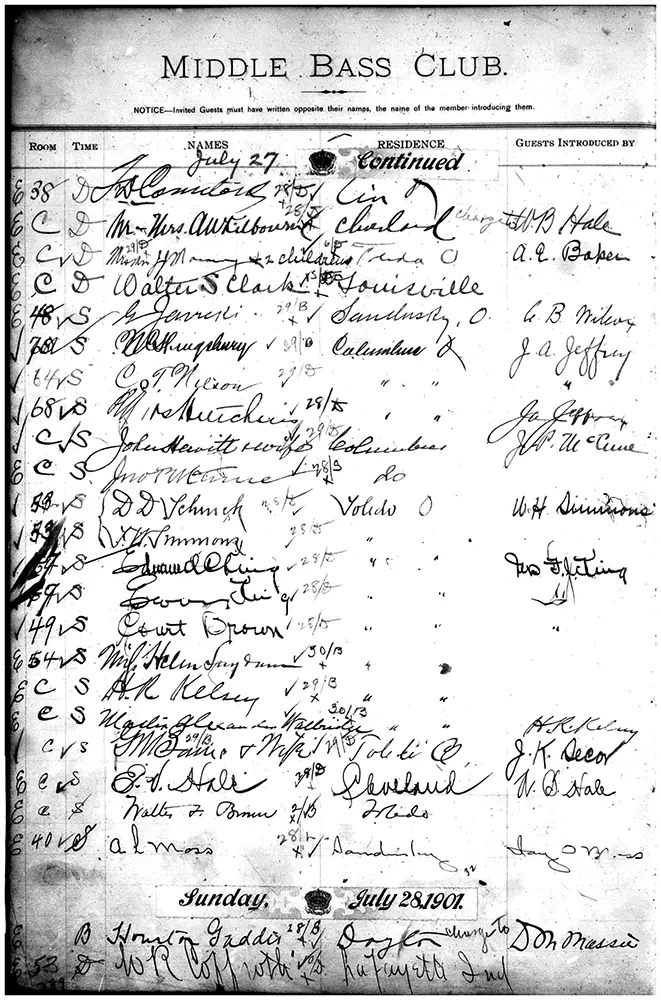 Middle Bass Club Guest Register entry: July 27, 1901
Middle Bass Club Guest Register entry: July 27, 1901
Rev. Emory W. Hunt
Rev. Emory W. Hunt of the Ashland Avenue Church in Toledo and later with Denison University, held six services in the Middle Bass Club Chapel on: August 26, 1888; July 30, 1893; July 8, 1894; July 19, 1903; August 30, 1903 and July 24, 1904. Rev. Hunt was the President of Denison University from 1901 to 1912. The Middle Bass Club members who attended the Ashland Avenue Church included: Charles T. Lewis and Thomas A. Taylor. Therefore, it makes sense that Rev. Hunt, his wife and child stayed at the cottage of member Charles T. Lewis in 1902 and 1903 because they knew one another from their home parish.
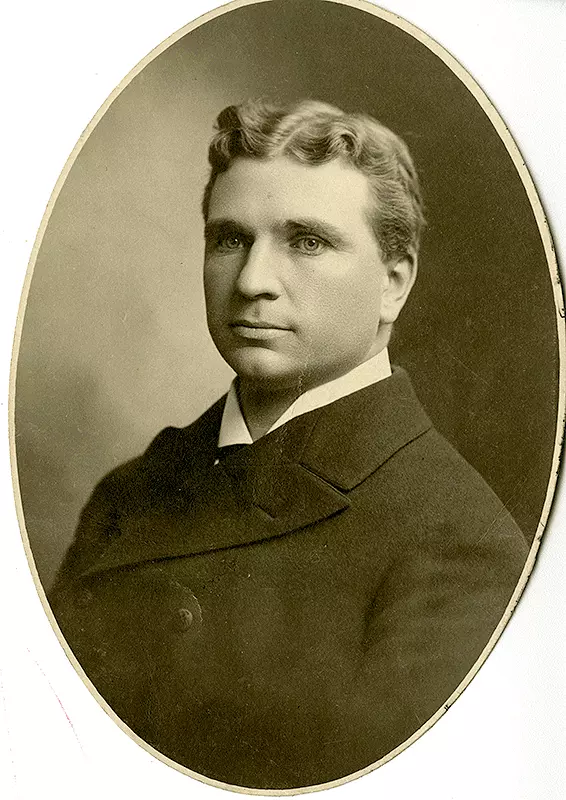 Portrait and photos of Rev. Emory W. Hunt from 1910 and 1913 (multiple photos). Source: Denison University Archives & Special Collections
Portrait and photos of Rev. Emory W. Hunt from 1910 and 1913 (multiple photos). Source: Denison University Archives & Special Collections
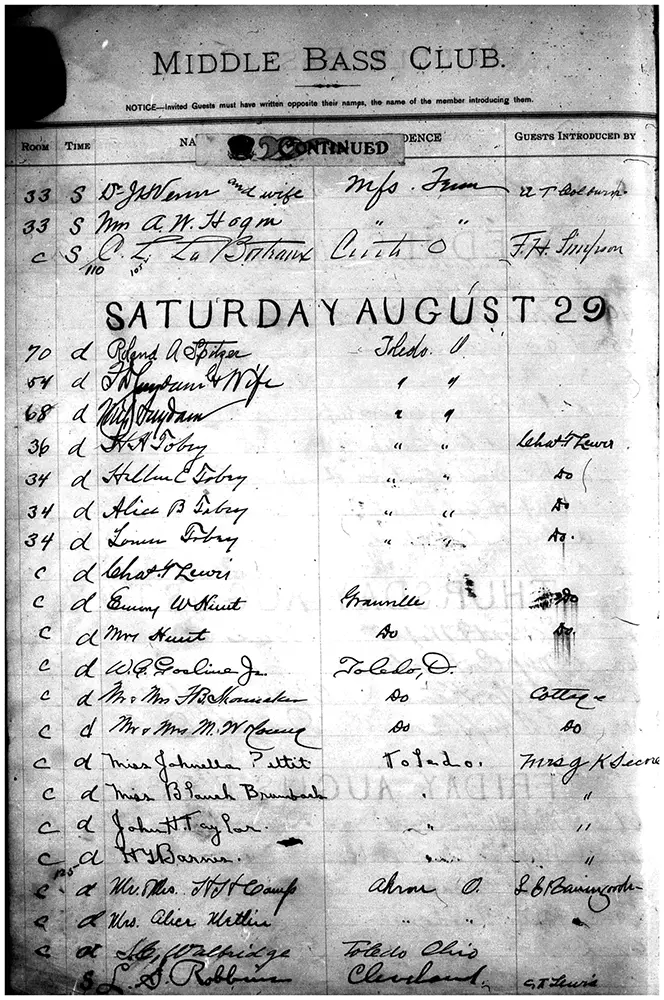 Middle Bass Club Guest Register entry: August 29, 1903
Middle Bass Club Guest Register entry: August 29, 1903
After leaving Denison University, Rev. Hunt was general secretary of the Baptist Foreign Mission Society of Boston for six years and a pastor in Newton, Massachusetts. In 1919, Rev. Hunt became President of Bucknell University and served in that position until 1931.
Rev. Simeon David Hutsinpillar
Rev. Simeon David Hutsinpillar of St. Paul’s Methodist Episcopal Church in Toledo led religious services five times in the Chapel on: July 20, 1890; July 19. 1891; July 24, 1892; July 16, 1893 and July 22, 1894.
Rev. James Alexander Porter McGaw
Rev. James Alexander Porter McGaw of the First Presbyterian Church in Toledo held services on July 21, 1889 “Cor. 5:1, Certainties About Heaven”; July 27, 1890 “Cor. 13:13, The Supreme Excellence of Love” and August 7, 1892 “Exod. 4:11, Man’s Mouth.” From 1888 until 1893 Rev. McGaw served the First Presbyterian Church in Toledo, Ohio. After Toledo, Rev. McGaw had parishes at Linwood Presbyterian Church in Kansas City, Missouri and the Third Presbyterian Church in Fort Wayne, Indiana. In 1904, Rev. McGaw moved to Oregon to preach in the following cities: Grants Pass, Salem, Portland, Union, Woodburn, Independence and at the Chemawa Indian School. (Source: University of Oregon Libraries, Special Collections and University Archives)
Rev. Dr. Thomas J. Melish
Rev. Dr. Thomas J. Melish from the St. Phillips Protestant Episcopal Church in Cincinnati, Ohio was the father of a Middle Bass Club member, William B. Melish (an active member from 1890 to 1907). Rev. Melish held services in the Chapel on August 5th and 12th, 1888. John Melish, Rev. Melish’s father and grandfather of Middle Bass Club member William B. Melish, mapped the state of Pennsylvania and corresponded with Thomas Jefferson at Monticello; the maps and correspondence are available in the United States Library of Congress.
Rev. Anson Smythe
Rev. Anson Smythe, of the Congregational denomination from Cleveland preached in the Chapel on Sunday, August 17, 1883. Earlier Rev. Smythe was a pastor at the Congregational Church of Toledo and became involved improving the city’s schools. While preaching and serving as the Superintendent of the Toledo public schools, Rev. Smythe became acquainted with numerous Middle Bass Club members. Rev. Smythe is considered one of the founders of the public school system of Ohio and the founder of the Cleveland public library. “The Reverend Anson Smyth earned his title of Father of the Cleveland Public Library as the originator of an enabling act which he was instrumental is pushing through the Ohio Legislature on April 3, 1867 authorizing the levying of a tax of one-tenth of a mill in Ohio cities of over 20,000 inhabitants for the enlargement and maintenance of public school libraries. It was this legislation that permitted the founding of our Library [Cleveland Public] in 1869. “ (Source: The Open Shelf, Cleveland Public Library, October-December 1969, Vol. 10-12.)
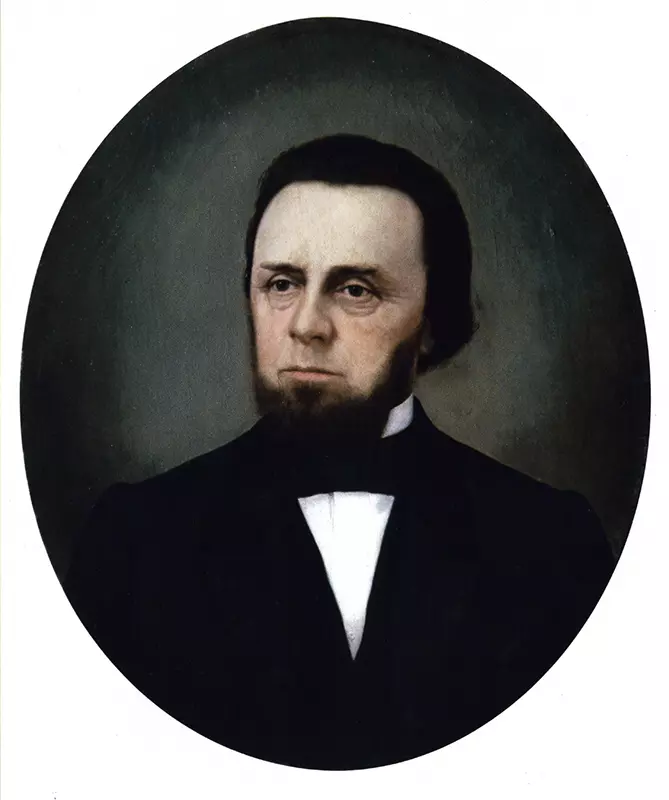 Rev. Anson Symthe. Source: Cleveland Public Library, Gift of Ralph Eddy Chapman. Circa 1888.
Rev. Anson Symthe. Source: Cleveland Public Library, Gift of Ralph Eddy Chapman. Circa 1888.
Rev. Wilson Reiff Steary
Rev. Wilson Reiff Stearly preached in the Middle Bass Club Chapel on August 17, 1902 and stayed at cottage of Middle Bass Club member Willis B. Hale. After studying for a year abroad in Paris and Berlin, Rev. Stearly enrolled and graduated from Union Theological Seminary. In 1889 he was ordained a minister in the Reformed Church and served as pastor of the Hough Avenue Reformed Church in Cleveland from 1889 to 1899. In 1900 joined the Episcopal Church and became rector of Emmanuel Church in Cleveland, Ohio from 1900 until 1909. Rev. Stearly later became the 4th Bishop of Newark in the Episcopal Church. Rev. Stearly was awarded a Doctor of Divinity from Kenyon College in 1915 and from Case Western Reserve University in 1916. (Source: Wikipedia)
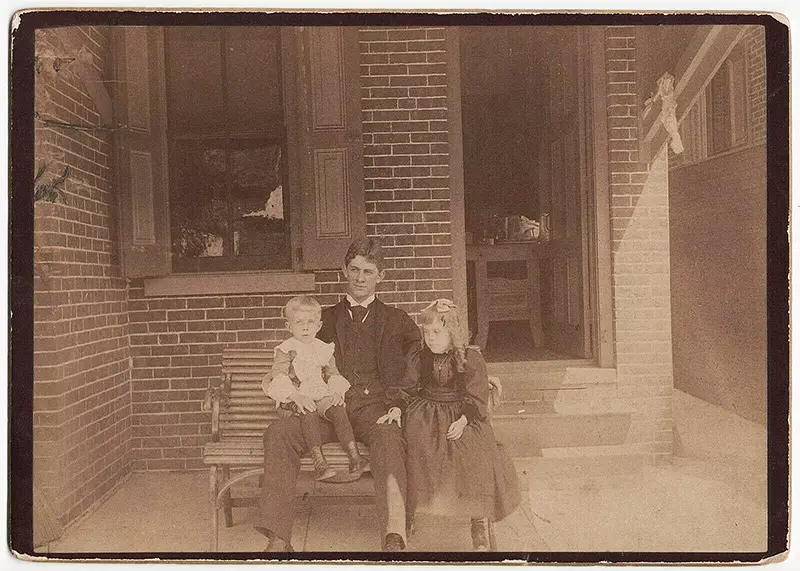 Rev. (and later Bishop) Wilson Reiff Stearly with his children, Source: Find a Grave
Rev. (and later Bishop) Wilson Reiff Stearly with his children, Source: Find a Grave
Professor Charles L. Williams
Professor Charles L. Williams led services in the Middle Bass Club Chapel on: August 24, 1902; July 17, 1904; July 15, 1906; August 9, 1908; August 23, 1908; August 30, 1908; August 8, 1909; August 15, 1909; August 28, 1910; July 2, 1911; August 6, 1911 and July 7, 1912. Professor Williams, another Rev. from Granville, Ohio, came to preach on Middle Bass Island following in the footsteps of the acting President of Denison University, Rev. Emory W. Hunt. He was a Professor of Rhetoric and English Literature at Denison University from 1893 until 1921. Interestingly, Professor Williams was a classmate of President Woodrow Wilson at Princeton University. Later, Professor Williams received his Doctor of Divinity from Crozier Theological Seminary at Upland, Pennsylvania. It should be noted that he wrote the following books: “The Story of Woodrow Wilson,” “A Study of Shakespeare as a Moral Writer” and “The American Student and the Road to Scholarship.” In 1902 Professor Williams stayed in Club House room 52 and was a guest of Middle Bass Club member Frederick J. Picard from Columbus, Ohio. From 1908 until 1912, Professor Williams appears to be the only minister to hold services in the Chapel as there are no other ministers listed in the Club House Guest Register books or the Middle Bass Chapel Association Records Book for those years.
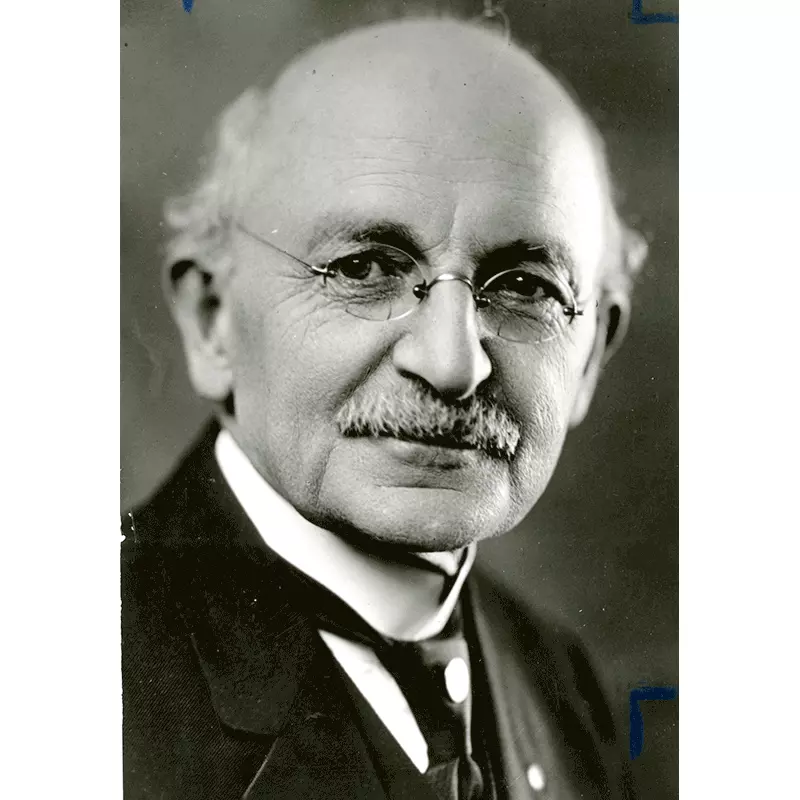 Portraits and a photo of Professor Charles L. Williams (multiple photos). Source: Denison University Archives & Special Collections
Portraits and a photo of Professor Charles L. Williams (multiple photos). Source: Denison University Archives & Special Collections
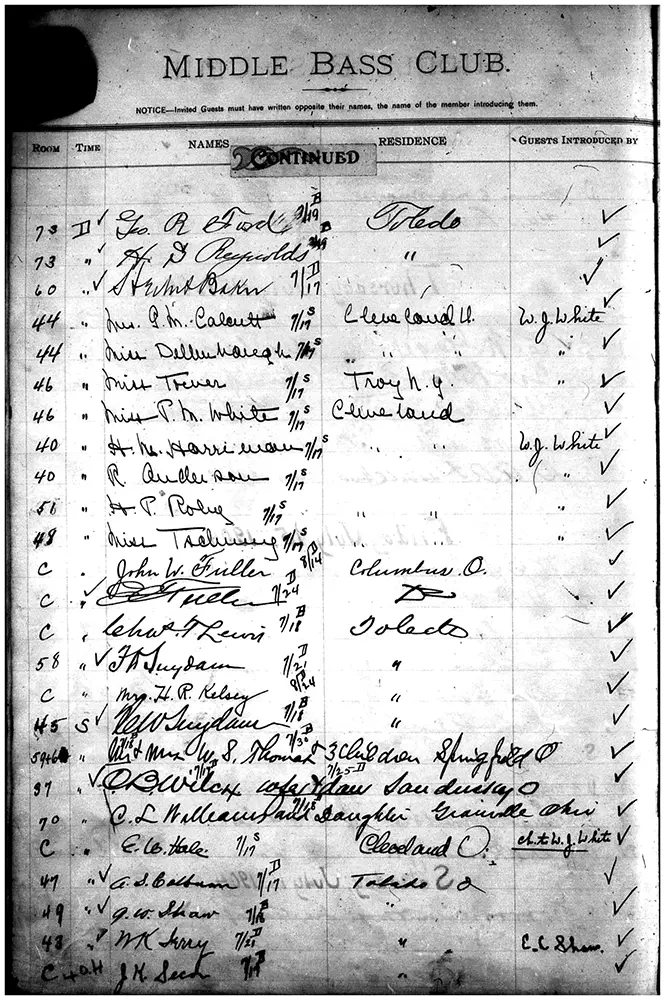 Middle Bass Club Guest Register entry: July 17, 1904
Middle Bass Club Guest Register entry: July 17, 1904
Rev. Thaddeus L. Wiltsee
Rev. Thaddeus L. Wiltsee from St. Paul’s Methodist Church in Toledo preached to the Middle Bass Club membership on July 5, 1885. He attended Northwestern University and then graduated from Ohio Wesleyan in 1873. Rev. Wiltsee spent time in Upper Sandusky and Marion before relocating to Toledo, Ohio where he was associated with the Broadway Church and St. Paul’s Methodist. During the 6 years spent in Toledo, Rev. Wiltsee came into contact with Middle Bass Club members. The Middle Bass Club membership respected Rev. Wiltsee’s professionalism and personality as he was invited to preach during a busy July 4th celebration weekend at the Middle Bass Club. Because of health concerns, Rev. Wiltsee left Toledo and moved out west where he was Superintendent of Missions in Arizona and established the first mission among the Navajo Indians. (Source: rootsweb)
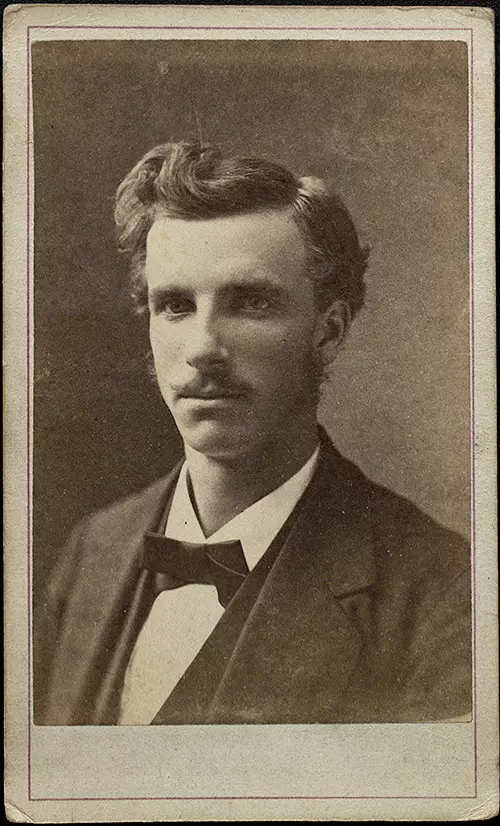 Rev. Thaddeus L. Wiltsee. Circa 1873. Source: Beeghly Library, Ohio Wesleyan University
Rev. Thaddeus L. Wiltsee. Circa 1873. Source: Beeghly Library, Ohio Wesleyan University
The Pulpit - Supplies
The only pulpit supplies (piano, hymnals, Sunday school papers) documented in the Middle Bass Chapel Association Records Book are listed below.
At the 1883 Annual Meeting held on August 6th, the Report of the Secretary [Miss Pamela Berdan] stated: “We also wish to return thanks to Mrs. Charles R. Messenger [Middle Bass Club member], who kindly donated a large Bible for the desk and above all, to Mr. William H. [Middle Bass Club member] Currier who each year, has most generously given us the use of a fine piano.” In 1884, a piano was rented from Whitney & Currier for $25.00. Since this was a significant cost, subscriptions for pianos were solicited in 1884 as well as the subscriptions for the Chapel. The subscriptions for pianos in the 1884 Treasurer’s Report totaled $25.10 and the subscriptions for the Chapel amounted to $34.50 highlighting both the high cost and importance of the Chapel having a piano. Tuning the piano in 1885 cost $6.50 and freight & tuning charges were $8.75 the following year. In 1887, the piano rental from Whitney & Currier was $36.15 and the freight was $1.50. The Records Book does not show any subscriptions for pianos after 1884.
The only other pulpit supplies identified in the Records Book include the following. In 1883, hymn books cost $25.20 and 50 lesson papers for use of Sunday School were purchased. In 1890, two dozen extra hymnals were purchased along with 6 large ones with music for the choir. In 1900, the Bible donated by Mrs. Charles R. Messenger was rebound.
